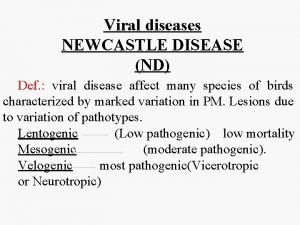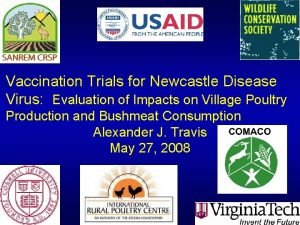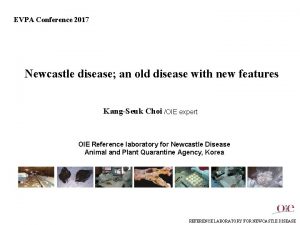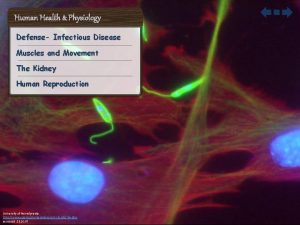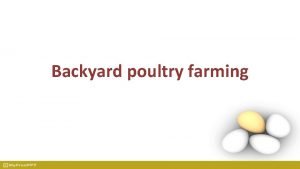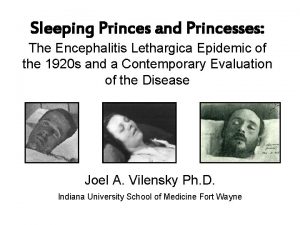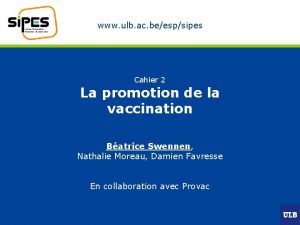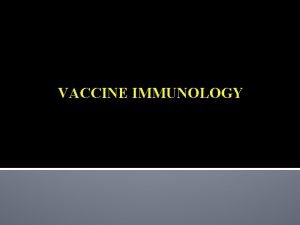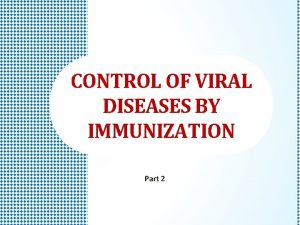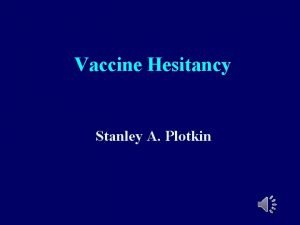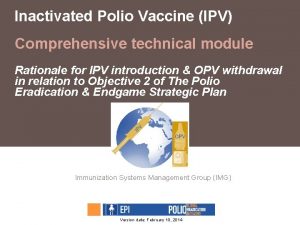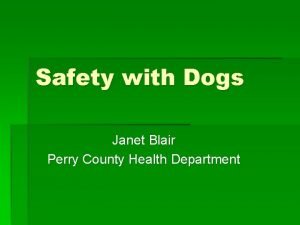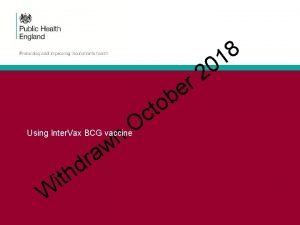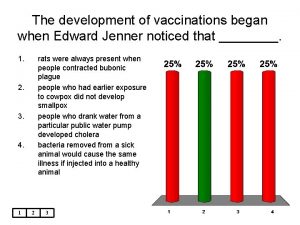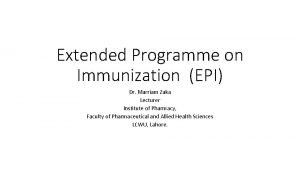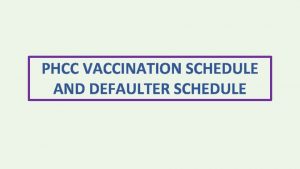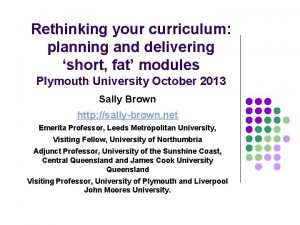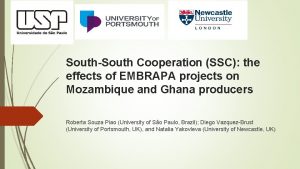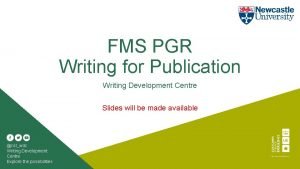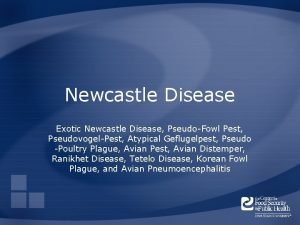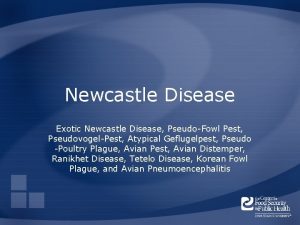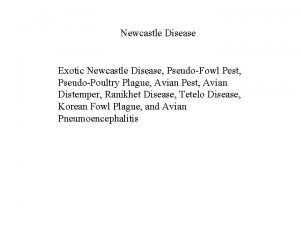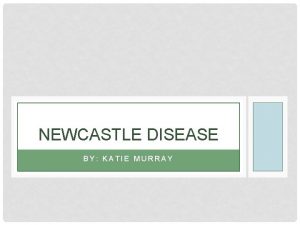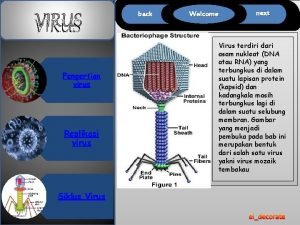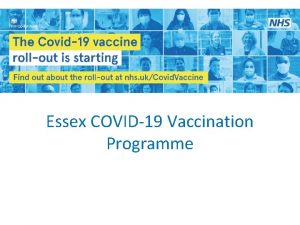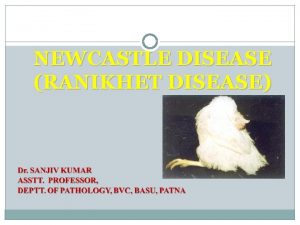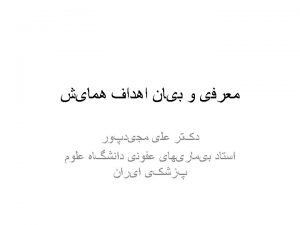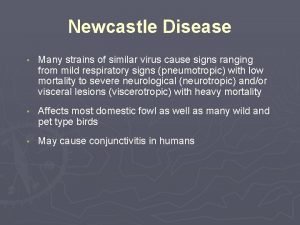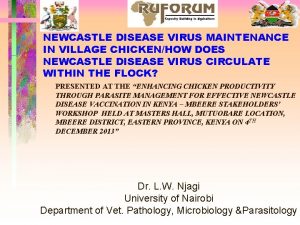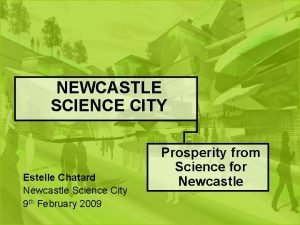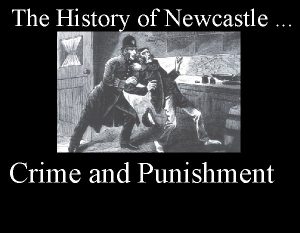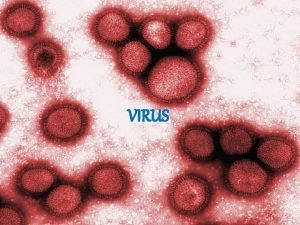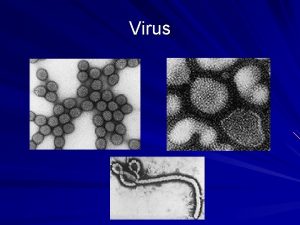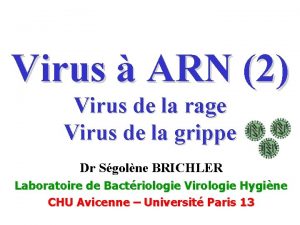Vaccination Trials for Newcastle Disease Virus Evaluation of























- Slides: 23

Vaccination Trials for Newcastle Disease Virus: Evaluation of Impacts on Village Poultry Production and Bushmeat Consumption Alexander J. Travis May 27, 2008

Specific Aims 2. To identify and integrate new technologies into the COMACO model to improve its profitability, food security, and rural incomes.

Research Veterinary Sciences: initial research: survey of causes of poultry mortality survey of husbandry practices Notes: poultry most common livestock species cattle uncommon (goats more common in S) livestock = “family savings account” not usually for consumption (not even eggs)

many villagers bring the chickens into their homes at night--increasing risk for HPAI

green diarrhea most likely from ND white diarrhea most likely from salmonellosis

data obtained by showing pictures of birds with the classical symptoms, and discussions

• initial recommendations: fresh water feed supplementation roost alteration cleaning/manure utilization will both improve soils and reduce parasite burdens • training during COMACO field days: in grant yr 1, >500 villagers, slightly more women than men, 11 sessions • generation of a poultry husbandy manual • training of COMACO extension officers and setting up a small lab

results from yr 1 50% increase of poultry numbers versus the same season the year before Problem: improvements in husbandry are not effective against endemic ND (high morbidity/mortality)

expanded research: Can a vaccination program for Newcastle Disease Virus improve village poultry production? Can this ND vaccination program be cost effective? Can we increase host nation capacity by training local community vaccination teams?

ND vaccination trial: 1. identify test and control village area groups (VAGS; one per chiefdom)


ND vaccination trial: 2. participatory appraisal of household flock patterns and needs

ND vaccination trial: 2. participatory appraisal of household flock patterns and needs (connections between poultry cycles and crop cycles) birds reproduce and grow best at end harvest (cool, dry, vegetation helps them hide from predators) birds have less access to food and are heat stressed as dry season progresses (high price of 15, 000 -20, 000 ZMK because sellers are food secure; no requirement that they sell) ND common at end of dry; flock sizes then decrease (death, sale before death, sometimes consumption of sick birds) food insecurity causes sale during wet season (low price 510, 000 ZMK) December holiday period often involves consumption

ND vaccination trial: 3. community identification of vaccination teams (1 M: 1 W); training over a 5 day period; design of vaccination cycles to meet community needs (3 cycles/yr: July, November, April) 4. implementation • • ND-V 4 HR vaccine (when freeze-dried, thermostable to 30˚C for a several months; when reconstituted stable up to 30˚C for a few hours) pricing: 250 ZMK/bird (175 for the vaccinators and 75 to COMACO to pay for vaccine) or trade [acceptance of price varied between villages]

Results:


similar data collected for chickens and eggs sold, chickens consumed, prices for chickens and eggs sold/purchased

Problems: floods in 2006 -2007 wet season severely affected food security, causing many families to sell chickens rather than vaccinate in Nov. 2007 (why vacc. if you are selling in a week? ) data not collected from 1/5 control villages (no compensation for illness of that individual) ethics of control villages: villagers perceive benefits of vaccination, want participation (one potential resolution would be to expand program, and add new control villages: significant increase in cost) formation/dissolution of “poultry groups”--need for data re-analysis

Problems: 4/10 original vaccination team members left, requiring training of new vaccination staff vaccination teams are concerned about the seasonal fluctuations in their income distances can cause vaccine to degrade after reconstitution (several hours above temp) seasonal movement of farmers to fields (in some areas) can change access to vaccinators

Research Veterinary Sciences: expanded research: Will this ND vaccination program impact local bushmeat consumption?

similar data collected for meat preferences, meat eaten, observations of meat eaten

potential economic model for economic assessment of intervention

Acknowledgements Cornell University Alfonso Torres Beth Buckles Jon Conrad Benjamin Lucio Alice Pell Erin Mc. Donald Tamika Lewis Emily Steubing Wildlife Conservation Society Dale Lewis Steve Osofsky Whiteson Daka International Rural Poultry Centre Robyn Alders Brigitte Bagnol
 Nd def
Nd def Newcastle disease
Newcastle disease Newcastle disease
Newcastle disease Communicable disease and non communicable disease
Communicable disease and non communicable disease Difference between spermatogenesis and oogenesis
Difference between spermatogenesis and oogenesis Poultry vaccination schedule
Poultry vaccination schedule Encephalitis lethargica
Encephalitis lethargica Vaccination bruxelles
Vaccination bruxelles Shine skis encapsulated
Shine skis encapsulated Vaccination schedule in palestine
Vaccination schedule in palestine Niccolo paganini powerpoint
Niccolo paganini powerpoint Mandatory vaccination
Mandatory vaccination Opv vs ipv
Opv vs ipv Dog spay perry county
Dog spay perry county Lokstallarna jönköping vaccination
Lokstallarna jönköping vaccination Vaccine vial monitors
Vaccine vial monitors Edward jenner
Edward jenner Epi schedule pakistan 2021
Epi schedule pakistan 2021 10 rights of medication administration
10 rights of medication administration Buccal fat removal newcastle
Buccal fat removal newcastle Universidade de newcastle
Universidade de newcastle Cloud computing newcastle
Cloud computing newcastle Writing development centre newcastle
Writing development centre newcastle Jake cowan newcastle
Jake cowan newcastle
